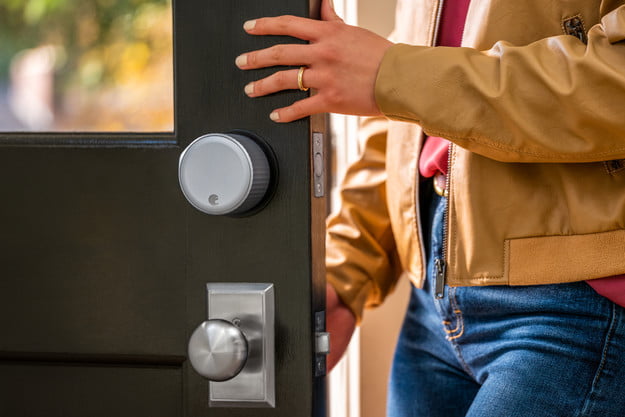Smart locks are an increasingly common sight around neighborhoods. These gadgets bring some modern amenities to your front door, letting you eschew your traditional key to operate your deadbolt with a password, fingerprint, or Bluetooth. If you’re curious to learn more about smart locks before adding one to your home, here’s everything you could want to know.
What is a smart lock?

At its most basic, a smart lock is an electronic lock that connects to your home and lets you open your door without needing a traditional key. This can be done using a keypad, smartphone app, and sometimes a fingerprint scanner.
There are a variety of reasons for adding one to your home, but one of the main reasons why homeowners prefer smart locks over traditional locks is their versatility — letting them give temporary passwords to visitors, removing the need to make copies of keys for family members, and providing peace of mind when away from home.
If you’re not ready for an all-digital door, you’ll be glad to know that many smart locks include a traditional keyhole in their design. This means you’ll benefit from all the smart home features while still being able to access your home with a key (a great option if the lock’s batteries die).
If you are using a keyless model and the battery dies, most offer some sort of way to manually power the lock (such as with a 9-volt battery), giving you enough juice to get into your home.
You’ll also be happy to know that smart locks are just as secure as traditional locks, and you won’t have to trade safety for convenience when adding one to your front door. Keyless smart locks are increasingly popular, as they’re often more challenging for a burglar to crack than a standard lock since there’s no keyhole to pick. Some obscure models might be susceptible to hacking, although models from trusted brands are typically ironclad.
Features offered by a smart lock

Smart locks bring a myriad of features to the table. These vary based on the exact model you’ve purchased, with premium locks typically offering more than their budget counterparts. Here’s a quick look at some of the tasks smart locks can perform.
- Unlock with keypad: Most smart locks include a keypad. This allows you to simply type in a password to unlock or lock the door — removing the need for a standard key.
- Unlock with a smartphone app: If you’ve installed a companion smartphone app when setting up your smart lock, you’ll get a bevy of additional features. One such feature is the ability to open your door remotely using your smartphone app. Conversely, you can use the app to ensure your door is locked when away from home.
- Set temporary password: Using your home as a short-term rental? Smart locks make it easy to secure your home for each new visitor by allowing for temporary passwords. These typically run alongside your permanent password, letting you quickly swap out codes whenever a new visitor books a room without deleting your primary password.
- Sync with your smart home: Smart home products come in all shapes and sizes, and smart locks often fit right into your existing ecosystem. This allows you to set a variety of parameters after unlocking or locking your door, such as turning off lights or changing the temperature of your home. Some smart locks can even connect to your home security system.
- Auto-lock functionality: There’s nothing worse than getting on the road and not remembering if you’ve locked your door. Opting for a premium smart lock negates this problem entirely, as many models let you enable an auto-lock function that’ll deadbolt your door after a few minutes of inactivity.
- Send smartphone alerts: Some smart locks let you enable push notifications to receive alerts when your door is locked or unlocked. This is especially useful if you’re having a dog sitter swing by your home while on vacation, letting you know when they arrive and ensuring the door locks when they leave.
Best smart locks to buy in 2023
If you’re ready to upgrade, we’ve compiled a detailed list of the best smart locks of 2023. But if you don’t want to wade through all the options, here are three standouts that are among the best on the market.
August Wi-Fi Smart Lock
Clocking in at $230, this smart lock brings heaps of functionality to the table — and looks good doing it. The August Wi-Fi Smart Lock connects directly to your home network without the need for a bridge or extra hardware, making setup a breeze. Once it’s done, you’ll benefit from a powerful smartphone app, an option to automatically lock/unlock based on your location, and compatibility with all of today’s hottest smart home ecosystems.
Wyze Lock
There’s no need to break the bank to install a smart lock, and nowhere is that more apparent than with the $130 Wyze Lock. Easy to install, stylish, and with a smartphone app that lets you remotely control the deadbolt, few products offer this sort of bang for your buck.
Yale Assure Lock 2
It’s not cheap, but the Yale Assure Lock 2 is one of the best smart locks available. Several different formats are up for grabs (including touchscreen and keyless options), and if you spring for a Wi-Fi-enabled model, you’ll gain access to your front door while away from home. Toss in the ability to create temporary profiles and monitor activities, plussupport for Apple Home, Alexa, and Google Home, and you’ve got a well-rounded smart lock that’s a great fit for most households.



